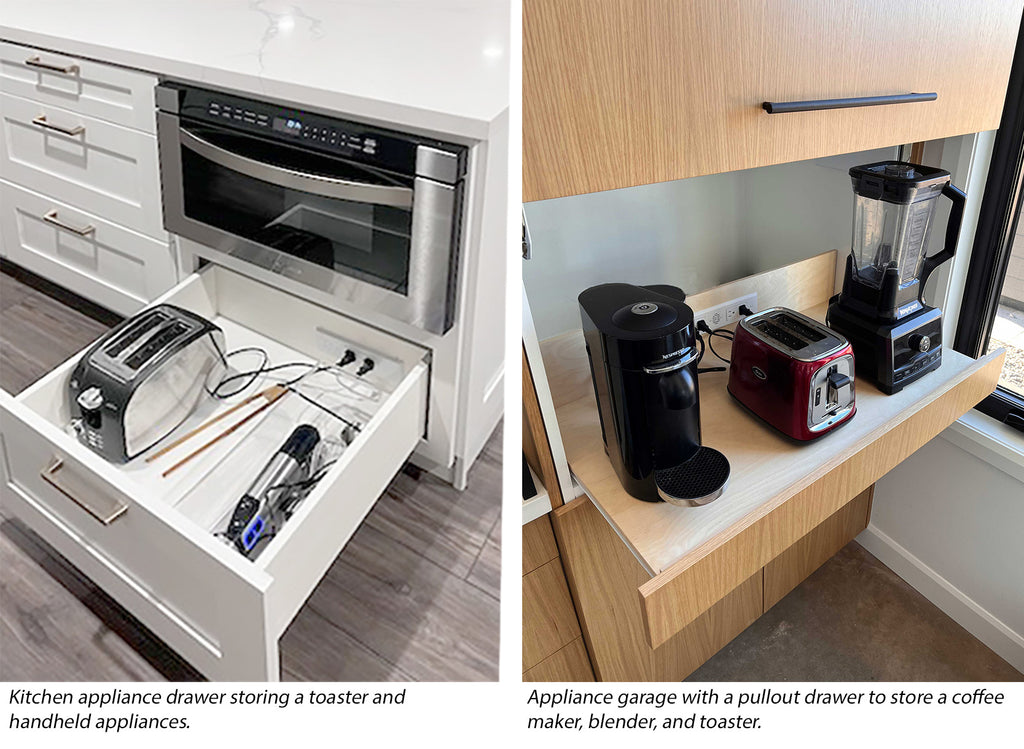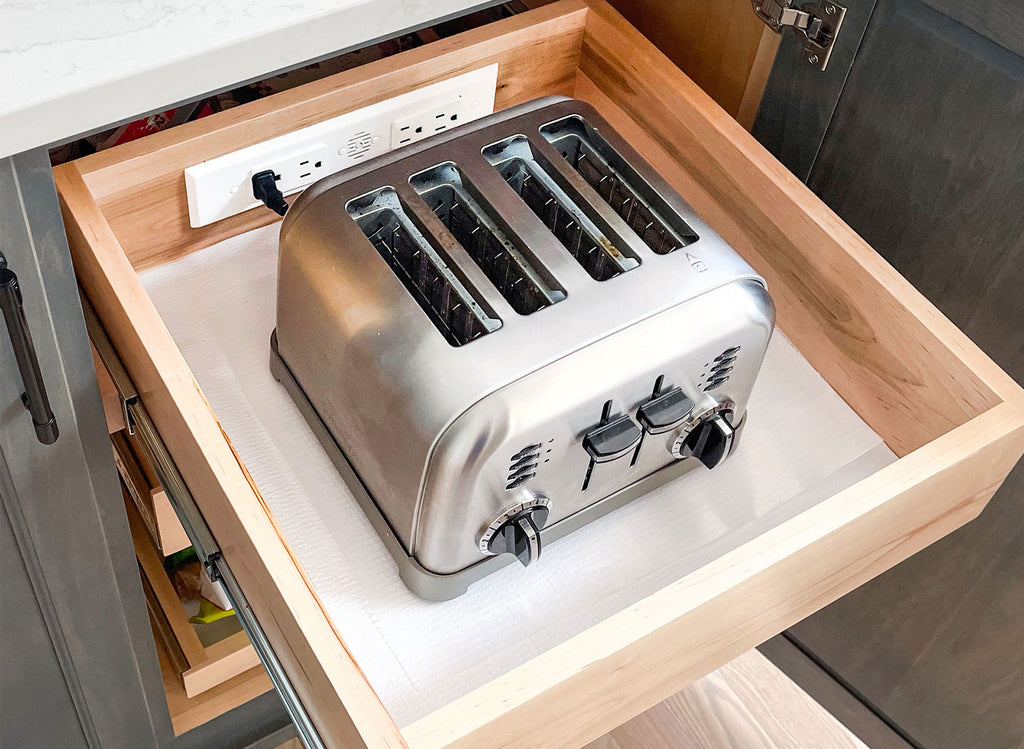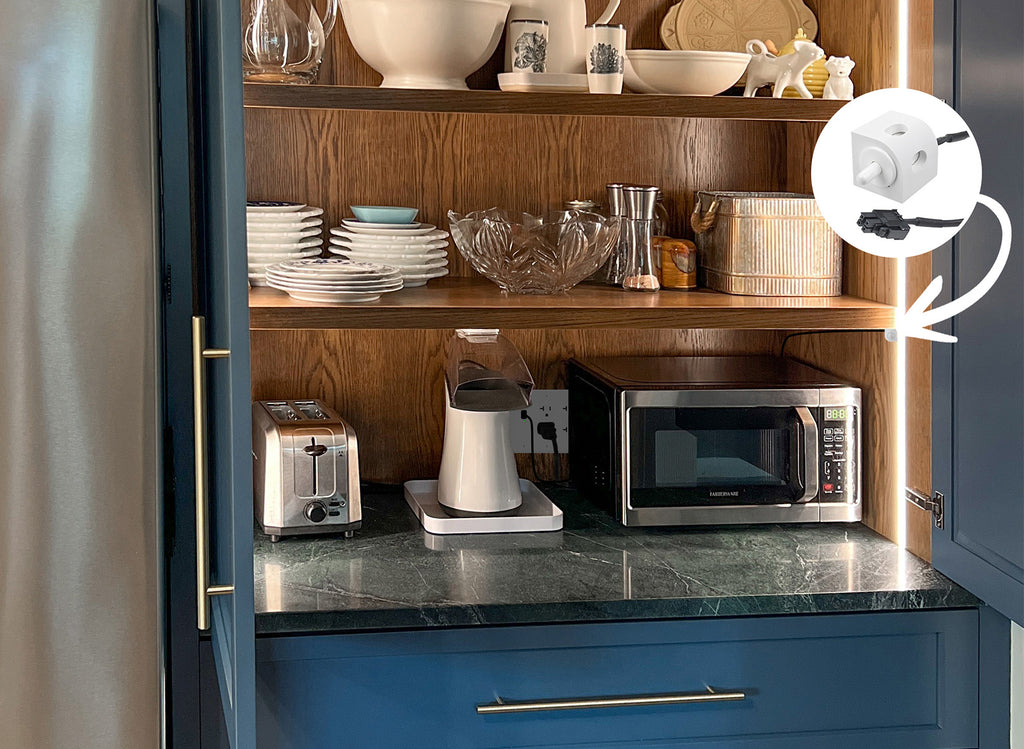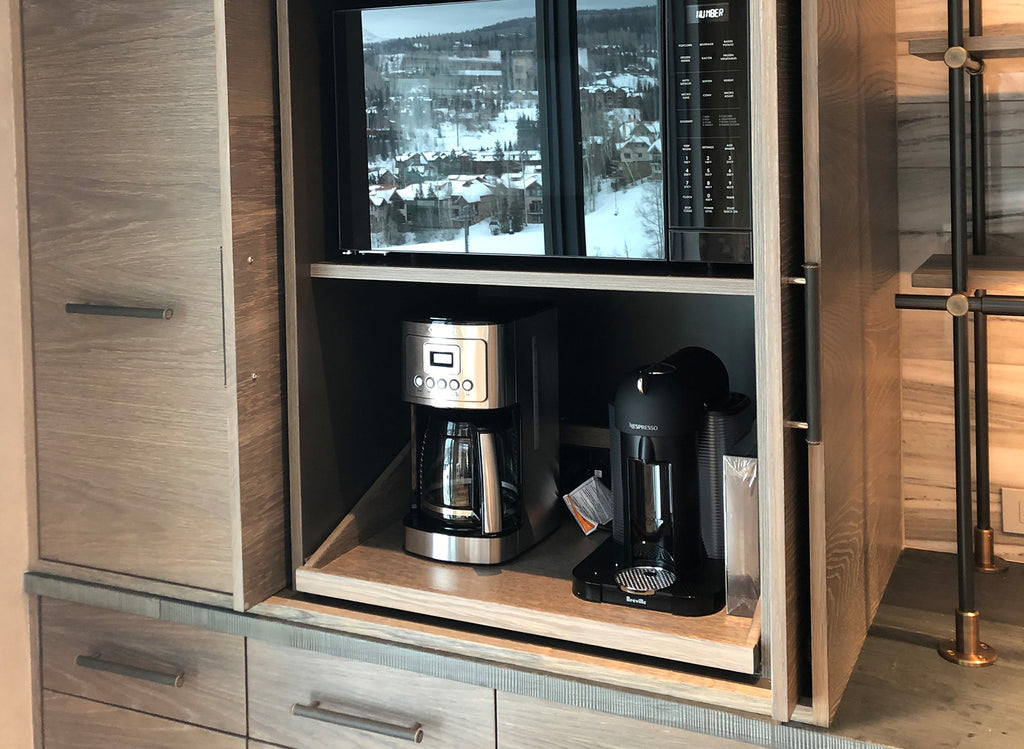In the modern kitchen, cluttered countertops can be a constant source of frustration, and thoughtfully organizing your kitchen and pantry areas are critical to the overall functionality of your space. Small appliances like toasters, blenders, and coffee makers often find their permanent residence on the countertop, taking up valuable surface space and creating an eyesore. But what if there was a better way for kitchen appliance storage? Enter appliance drawers and appliance garages, two ingenious solutions that offer many benefits, from improved safety to enhanced functionality as a result of more purposeful use of your space.
The Difference Between Appliance Drawers & Appliance Garages
The main difference between appliance drawers and appliance garages is their overall configuration and accessibility. Appliance drawers can be incorporated into the kitchen with ease at any time by simply dedicating a deeper cabinet or island drawer to discreet storage for small appliances. An appliance drawer offers quick and easy access to appliances, with the added benefit of keeping cords and clutter out of sight.
On the other hand, appliance garages are typically built into the cabinetry design or retrofitted into cabinetry during kitchen renovations. These enclosed kitchen storage compartments feature hinged or retractable doors that are used to conceal appliances when not in use. While appliance garages offer a similar function of hiding small appliances, they are often larger in size and can accommodate bulkier items such as stand mixers or food processors.

The Collective Benefits of Enhanced Appliance Storage
Whichever method you choose, you will experience a few collective benefits of enhancing your appliance storage:
-
Convenience: Getting small appliances off the countertop while keeping them plugged in and ready for use offers unparalleled convenience. No more rummaging through cluttered cupboards or pantries to find the blender or toaster then putting them away again after each use. Everything is neatly organized and readily accessible, streamlining your cooking process and saving time and effort.
-
Safety: With cords tucked away inside the drawer or cabinet, you’re eliminating exposed wires from hanging off the kitchen surfaces or sides of the island, avoiding tripping hazards and the risk of children or pets tugging on the wires and pulling devices off the surface.
- Efficiency: By freeing up valuable countertop space, appliance drawers and garages enhance the efficiency of your kitchen layout. With more workspace available, you can quickly spread out and tackle meal preparation tasks. Whether chopping vegetables, kneading dough, or assembling ingredients, having a clutter-free countertop can make all the difference in your cooking experience.
Appliance Drawers: A Simple Kitchen Appliance Storage Solution
Appliance drawers offer a sleek and discreet solution for storing small appliances. Incorporating a Docking Drawer in-drawer outlet will allow you to power your devices safely from inside the open drawer, without the need to move appliances in and out of the drawer before and after use. Popular options like this Docking Drawer Blade In-Drawer Outlet will allow you to power your small appliances with convenience and peace of mind. Our in-drawer outlets are ETL Listed for use in the US & Canada, and come standard with an integrated thermostat that will de-energize the outlet if drawer box temperatures exceed 120 °F, making them safe for use in kitchen appliance drawers. A toaster is powered and stored in a kitchen appliance drawer.
A toaster is powered and stored in a kitchen appliance drawer.
For those seeking an additional layer of safety, check out our Appliance In-Drawer Outlet Kits, which pair our in-drawer outlet with a Blade Safety Limit Switch. This safety add-on senses the drawer’s position and cuts power to the in-drawer outlet and all connected devices as the drawer begins to close, guaranteeing no devices are ever left powered on inside the drawer.
 Blenders are stored in a kitchen appliance drawer powered by Docking Drawer.
Blenders are stored in a kitchen appliance drawer powered by Docking Drawer.
Benefits of Powered Appliance Drawers
-
Flexibility: Unlike an appliance garage which requires cabinetry planning, you can dedicate a drawer to appliance storage at any time. We recommend dedicating a deeper middle drawer, which will accommodate a variety of small appliances like toasters and blenders while staying within easy reach.
- Accessibility: Since an appliance garage is typically located at the back of the countertop, within the cabinet, appliance drawers can be more accessible for children and people with disabilities.
Appliance Garage: A Versatile Kitchen Appliance Storage Solution
Appliance garages offer a versatile storage solution for small appliances, keeping them hidden from view behind cabinet doors. We offer several safety outlet solutions that are designed to sense the position of your cabinet door and cut power to the wall outlet whenever the door begins to close, offering a layer of safety for appliance garage setups by ensuring that no devices are ever left powered on behind the cabinet door. This added safety outlet also ensures compliance with Canadian Electrical Codes, which require high-voltage outlets to be de-energized inside the cabinet. An appliance garage can be a powerful way to make the most of your kitchen space, ensuring small appliances are always plugged in and ready while otherwise neatly concealed behind the cabinet door.
 Coffee appliances and a toaster are stored in an appliance garage featuring the Safety Interlock Disconnect with Corner Mount Limit Switch.
Coffee appliances and a toaster are stored in an appliance garage featuring the Safety Interlock Disconnect with Corner Mount Limit Switch.
Benefits of Appliance Garages
-
Versatility: Due to the nature of their location, the appliance garage often accommodates larger and taller appliances that might not be possible to stow in side a powered appliance drawer, like blenders, espresso machines, coffee grinders and more.
- Customization: Since an appliance garage is typically a planned part of your kitchen cabinetry, you have the ability to customize this storage solution to your specific needs and preferences. Choose from a variety of finishes, styles, and door options to create a cohesive and integrated look that complements your cabinetry and overall design scheme.
 A modern appliance garage featuring a pullout tray for easy storage and access.
A modern appliance garage featuring a pullout tray for easy storage and access.
Do I Need an Appliance Garage or an Appliance Drawer?
When deciding between integrating an appliance drawer or an appliance garage into your kitchen, it's essential to consider several factors:
-
Assess Available Space: Evaluate your kitchen layout and determine the available space for kitchen appliance storage solutions. If you have ample drawer space, an appliance drawer may be preferable. Alternatively, an appliance garage could be better if drawer space is limited but you have plenty of cabinetry.
-
Consider Accessibility: Think about how you use your kitchen daily. If you prefer the convenience of accessing small appliances quickly from within drawers, or if you have children or people with disabilities in the household, an appliance drawer may be the ideal choice.
-
Evaluate Storage Needs: Consider the size and quantity of small appliances you need to store. An appliance drawer may be suitable for smaller items like blenders or toasters, while an appliance garage can accommodate larger appliances like stand mixers or coffee makers.
- Determine Modification Capacity: An appliance garage requires more planning, and is most commonly planned into a kitchen design or renovation project. You may have the ability to modify existing cabinetry with little overhead, but if you're looking to add the functionality of hidden appliance storage into your current kitchen layout without construction requirements, a powered appliance drawer is far easier to retrofit into existing space.
Ultimately, deciding between an appliance drawer and an appliance garage boils down to your stage of project planning, your personal preferences, accessibility needs, kitchen layout, and lifestyle factors. It's important to note that you don't have to choose! If kitchen space allows, consider incorporating both appliance garages and appliance drawers to maximize storage versatility and convenience in your kitchen design. By carefully weighing these considerations, you can choose the option that best fits your needs and enhances the efficiency and aesthetics of your kitchen space.
